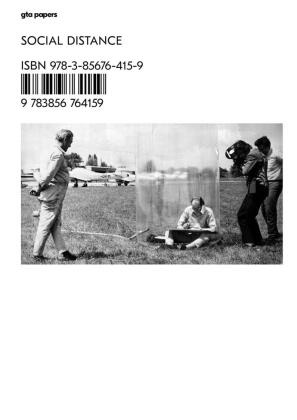Read more
Der Ausdruck «Soziale Distanz» hat bisher als vage Metapher das Verhältnis verschiedener gesellschaftlicher Gruppen beschrieben. Mittlerweile hat er eine präzise Bedeutung als obligatorischer Mindestabstand für persönliche Kontakte erlangt: 1, 1,5 oder 2 Meter (oder 6 Fuss) - je nach staatlicher Verordnung. Was aber ist die angemessene Distanz, von der aus eine Pandemie zu interpretieren wäre? Anstatt eine Diagnose der gegenwärtigen Notsituation zu stellen, eröffnet das Heft Social Distance Perspektiven aus der Architekturgeschichte und Architekturtheorie. Von der grossen Pest in Venedig bis zur Cholera in der sich industrialisierenden Grossstadt, von der menschlichen Plazenta bis zum Bubble Office der 1960er Jahre oder dem Heimbüro von heute bietet die fünfte Ausgabe der gta papers ein breites Spektrum von Überlegungen zu den Themen Ansteckung, Krankheit und Gesundheit.
List of contents
Adam Jasper: lntroduction 4 Markus Wörgötter: Burnacini's Cloud 6 Laila Seewang: The Prophylactic Landscape 14 Lydia Xynogala: On Airs, Waters, and Places 27 Christa Kamleithner: Dangerous Congestions 38 Milos Kosec and Leslie Topp: lnfection and the Politics of Space 50 Gregorio Astengo: The London Wall and the Great Plague of 1665 62 Britta Hentschel: The Villa 15Daniel Weiss: From the gta Archives 84 Alex Winiger: Medical Progress and Social Revolution 92 Jeanne Kisacky: A Room of One's Own 101 Annmarie Adams and David Theodore: Separate and Together 109lrina Davidovici: H: Hospital-as-City 118 Didem Ekici: Airborne lnfedion and Breathing Walls 132 Chair of the History and Theory of Urban Design: The Viral Balcony 138 Lukas Stadelmann: "We Have Enough Food-That Wasn't the Problem" 151 Stanislaus von Moos: From the Bear Pit 160 Caroline A. Jones: Syncytium 167 Cathelijne Nuijsink: Some lnflated Expedations 176 Anne Kockelkorn and Reinhold Martin Reconstrudion and Redistribution 187

